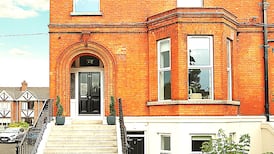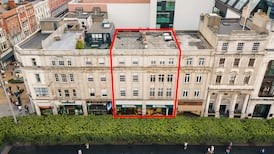Princess Frances Colonna di Stigliano has reigned over Clonmannon for more than 40 years. She and her first husband purchased it from the Chester Beatty estate in 1968.
At her 17th century sprawling home close to Ashford, Co Wicklow, the first striking impression is her glorious garden, containing tropical plants, lakes, bridges and wonderfully carved wooden furniture, shining brightly despite the wintry bleakness. A winding avenue eventually leads to the Palladian mansion on a small hilltop, to be met by the princess and her one-year- old much-loved Dalmatian, Kabul Two.
“Its lovely isn’t it,” she says as we stand outside her 300-year-old redbrick house. “I used to work as an auctioneer on Merrion Row, just off Baggot Street: that’s how I came across the place. When we bought it, it came with 600 acres and the big house over there,” she said, pointing towards a large Georgian mansion, which was built by the Tuelle family in the 18th century.
0 of 3
According to the original sales catalogue from James Adam & Sons from May 14th, 1968, oil paintings, a library of books and “curious objects of art & vertu” were also sold with the estate, though clearly the lady of the manor has injected much of her own style into both the home and the gardens.
Ms Colonna, who was born Frances Loftus in Connemara, lived in the bigger Georgian mansion with her first husband Kenneth Wilby and their three children for her first years on the estate. Later her eldest daughter Jayne was married briefly to the Carnarvon heir. His family seat is the Jacobethan style Highclere Castle, Berkshire, UK, better known to TV viewers as Downton Abbey.
Recording studio
After Ms Colonna and her husband separated, she sold off parts of the land, including the Georgian house, which had been built in 1780 by the wealthy landowning Truell family. After the Colonna’s sold it in the 1980s, it became the focal point of a retirement village that never quite got off the ground.
The village comprised the main mansion, 46 retirement bungalows and 24 acres of land. People who purchased leaseholds were offered packages including a nursing home and dining and social facilities in Clonmannon House.
Here they could avail of a grand communal drawing room, dining room, library and billiards room. It was planned to deliver a comprehensive scheme of care, but it failed to live up to expectations and ran into financial difficulties in the early 1990s By the turn of the century, it had gone into liquidation three times. In 2001, it was turned into an unauthorised recording studio, and at one point the retirement village was owned by a consortium. But little is known of the main house now. “Its very elusive,” a local business owner said. “As far as we know the nursing home is gone, there are only a handful of people left in the cottages.”
Ms Colonna shakes her head when asked about the house, just a few hundred metres from her own.
“I know the previous owners built it because this house became too small for them, but I’m not quite sure what happened to it after we sold it. I know there was quite a lot of controversy,” she adds. “But it was a great party house. We had lots of parties up there, it was a great spot for entertaining in those big old rooms.”
Set in a wooded demesne, it is a little more modest than the latter, especially after the south wing was demolished in the early part of the 20th century and replaced with a single-storey annex.
“When we moved down here in 1984, the house was in ruins. We did it up using salvage materials, some of which came from the Hibernian Hotel in Dublin.”
By “we”, she is referring to her husband, Florentine prince Prospero Colonna (of an Italian noble family made powerful in medieval and Renaissance Rome, supplying a pope and other religious and political leaders), and their two daughters, who are now both in their 30s.
“We met while I was training horses in Wicklow,” she explains. Unlike many country houses, the house is warm, without the usual brittle window frames, cold bathrooms, Superser heaters and indoor breezes you come to expect.
The long kitchen table between the fireplace and the window provides a great spot for tea, but we don’t hang around. “I’ll show you around the house; you must see the dungeon downstairs,” she says, as we wander through the drawingroom and dining area on the ground floor, romantic and quirky rooms, yet homely, with some lovely Italian pieces from her husband’s side of the family.
“This is the fun room. We used to have lots of parties down here,” she says, as we walk down wooden stairs to the basement room, dominated by a large oval table and red velvet chairs.
“Cromwell’s army used to hang their clothes to dry by the fireplace after battle.”
Tented ceiling
Back on the landing and up the main stairs, a delightful sittingroom with twin wing back armchairs and a large fireplace awaits. It is reminiscent of a country house parlour. The first floor boasts opulent guest bedrooms with bottled water and glasses on the bedside tables and panelled bathrooms.
On the next level again there are more bedrooms decorated in bright yellow and blue, with fabric walls and ceilings and another drawing room with a fireplace.
On the top floor is a particularly impressive step-up bath, with a tented ceiling and large Italian beds adding to the general ambience. “We haven’t done anything to it since we did it up 30 years ago,” she says.
There are many endearing features throughout the house; and in particular paintings by her daughter Vittoria Colonna, an award-winning Irish film director living in Los Angeles.
They decorate the walls along the unused stable at the back of the house, converting the small bungalow by the gardens into a kind of art gallery. “There’s no electricity in here,” she says of the small house. “Which is fine, we use candles when we have people in.”
For Princess Colonna, her passion is her garden, where she works most days. “I’m out every day. But we need to do more for the bees. It’s so important to have the right plants for bees to be able to pollinate.”













